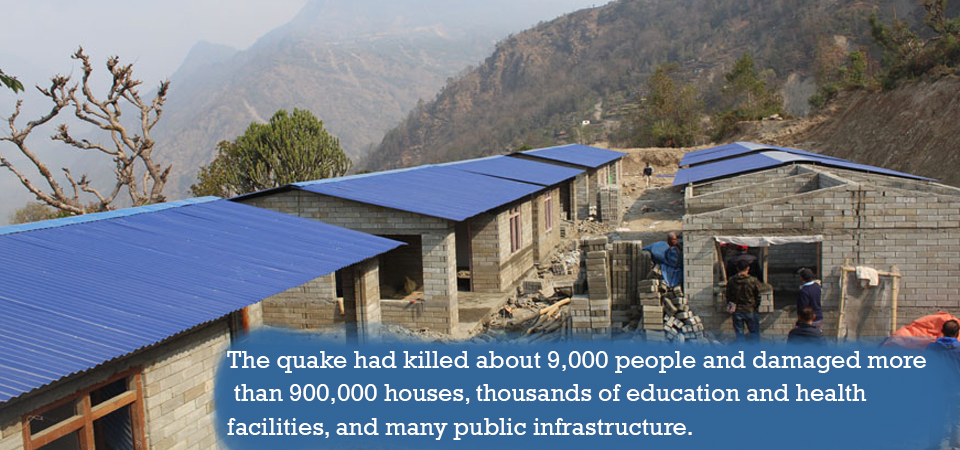Half quake-hit families recover their productive assets

By Modnath Dhakal
Kathmandu, Nov. 28: More than half of the households in the districts affected by 2015 Gorkha Earthquake have reported complete recovery of the productive assets.
Preliminary results of a study by the Central Department of Economics (CEDECON) at the Tribhuvan University showed that 51.6 per cent of the households reported complete recovery of the productive assets such as crops, cattle, cattle shed, poultry and farm while 46.9 per cent families could recover their properties partially.
The study titled ‘Natural disaster and asset recovery: Empirical evidence from Nepal’s earthquake’ was conducted by a team led by Dr. Nirmal Kumar Raut, Assistant Professor at the CEDECON.
The study has primarily evaluated the recovery situation of productive assets such as crops, cattle, cattle shed, poultry, and farm of the rural households and the effectiveness of assets protection strategies they resorted to during the recovery process.
“This study finds that in terms of assets protection strategies, aid/relief and migration/remittances as effective strategies for partial recovery of lost productive assets while political network, particularly a friend or a relative as an elected local representative, helped households recover their assets completely,” said Dr. Raut.
While some people reported that the political connections were instrumental for them to obtain grants and other support from the government, the study concluded that pre-existing socio-economic inequalities may have deprived the disadvantaged from receiving the reliefs, aids and participations in the recovery programmes.
Dr. Raut said that disaster risk reduction policies and guidelines should also incorporate plans and specific strategies to economic recovery including recovery of productive assets. This will help expedite the recovery process.
The study is based on the resurvey of 50 per cent samples from nine quake affected districts, 34 rural units and 680 households surveyed in Nepal earthquake data collected by the Central Department of Population Studies at the TU in November and December 2015.
The quake had killed about 9,000 people and damaged more than 900,000 houses, thousands of education and health facilities, and many public infrastructure.
Speaking at the result dissemination programme on Saturday, Dr. Bishnu Bahadur Bhandari, National Reconstruction Authority (NRA) member, said that Nepal’s reconstruction process had created many good examples.
“The decision to deposit the money directly to the bank account of the beneficiaries of the disaster has helped in expanding the reach of and access to banking and reduction in corruption. This will have a long-term positive impact on Nepal’s economy,” he said.
Likewise, the NRA had practiced tripartite agreement in aid mobilisation. If any non-government organistaion wanted to work in the reconstruction work, it had to obtain approval from the NRA and work with the local bodies, said Dr. Bhandari.
The NRA is working with about 390 organisations. Unlike in other quake-affected countries including Haiti, Nepal had formulated a guideline to mobilise the I/NGOs.
“The entire reconstruction drive couldn’t contribute much to the social reconstruction or recovery. It would have been better if the campaign was named as a recovery or rehabilitation,” Dr. Bhandari said. According to him, empirical studies like this can be a guiding document in the recovery efforts in the future.
However, experts said that rural heritage was lost in the course of reconstruction. Although the NRA supplied housing catalogue included models of traditional and heritage homes, most of the families opted for easy and low-cost concrete houses.
Prof. Dr. Shiva Lal Bhusal, Rector of the TU, said that the university had suggested the government to carry out research through the universities.
“It is a good thing that many professors and teaching faculties are involved in research works while the university has directed the departments and institutes to allocate a certain amount of budget to research works,” he said.
Prof. Dr. Shiva Raj Adhikari, Head of CEDECON, said that the study on asset recovery was a unique research in the post-quake rehabilitation since there are very few studies in terms of assets and their recovery.
Recent News

Do not make expressions casting dout on election: EC
14 Apr, 2022
CM Bhatta says may New Year 2079 BS inspire positive thinking
14 Apr, 2022
Three new cases, 44 recoveries in 24 hours
14 Apr, 2022
689 climbers of 84 teams so far acquire permits for climbing various peaks this spring season
14 Apr, 2022
How the rising cost of living crisis is impacting Nepal
14 Apr, 2022
US military confirms an interstellar meteor collided with Earth
14 Apr, 2022
Valneva Covid vaccine approved for use in UK
14 Apr, 2022
Chair Prachanda highlights need of unity among Maoist, Communist forces
14 Apr, 2022
Ranbir Kapoor and Alia Bhatt: Bollywood toasts star couple on wedding
14 Apr, 2022
President Bhandari confers decorations (Photo Feature)
14 Apr, 2022











